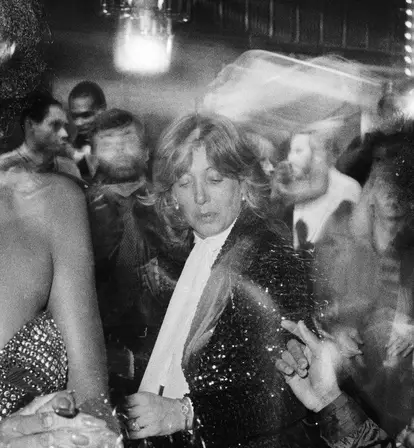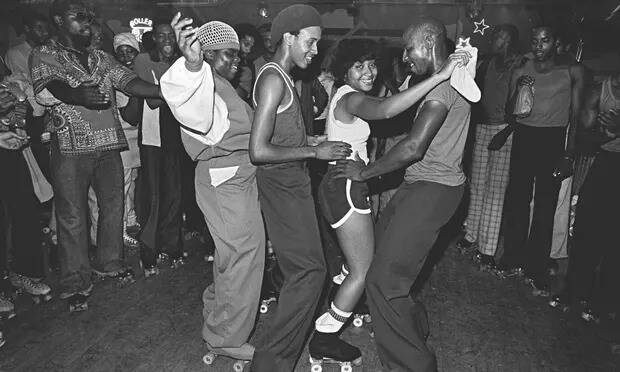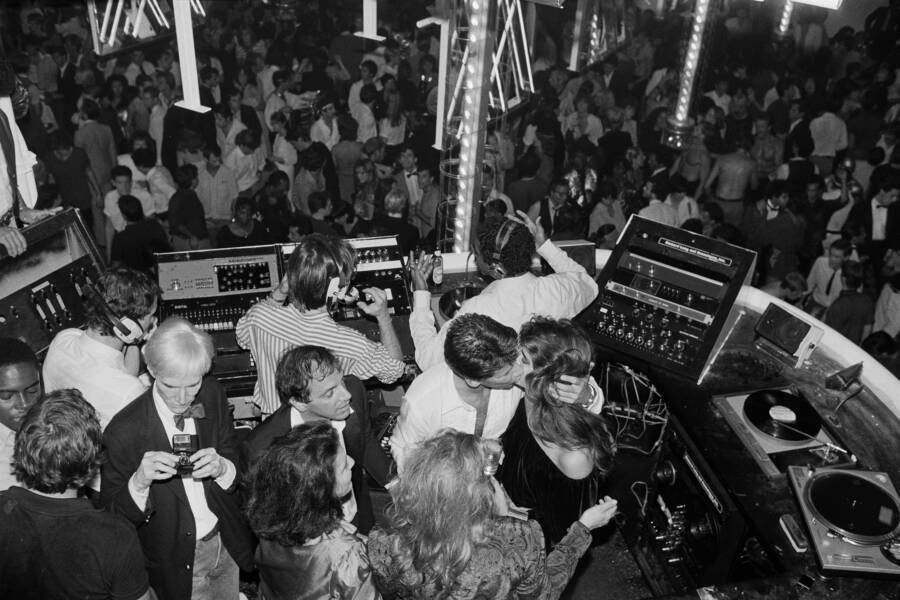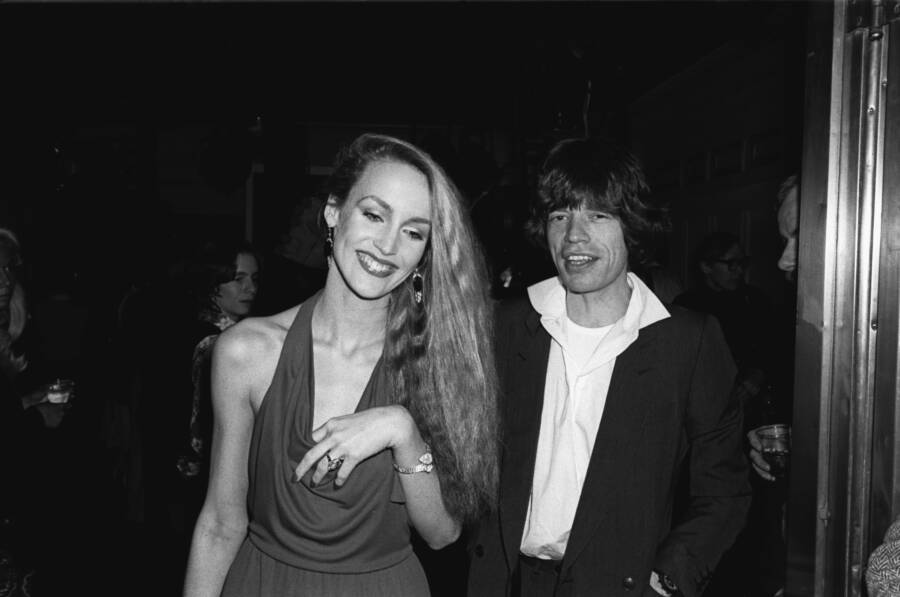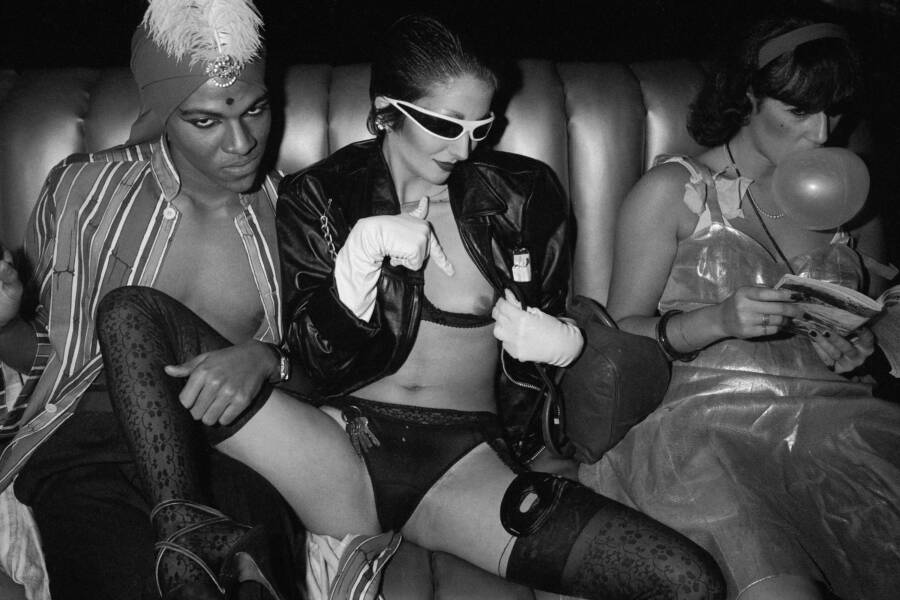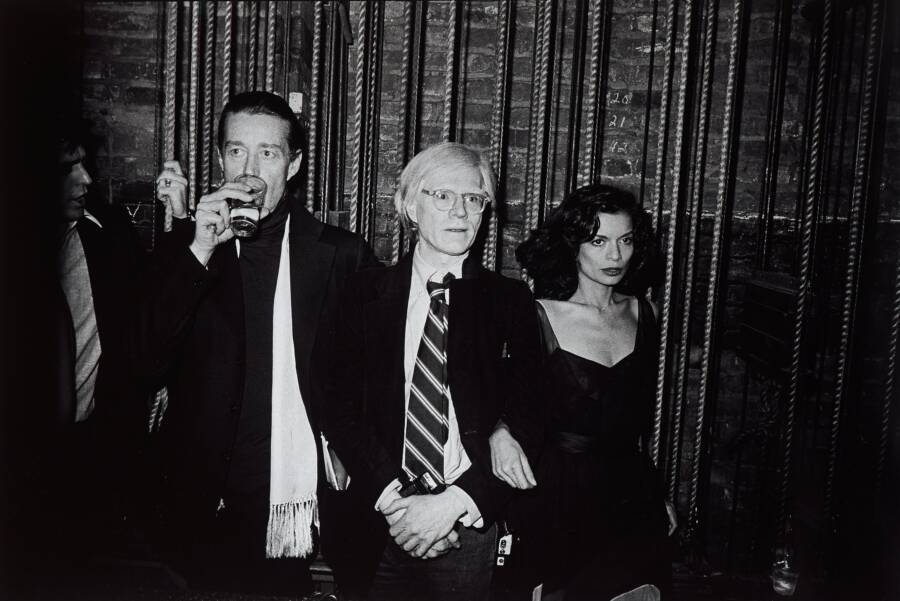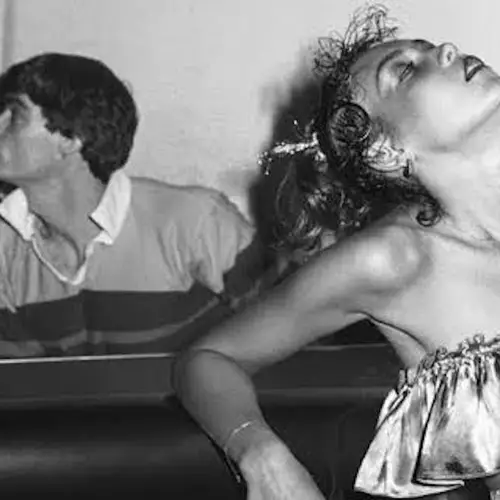Hustle into the 1970s with these eye-popping photos from when disco took over the world.
The disco era emerged from a period of political upheaval. After the Vietnam War, the Watergate scandal, and the assassination of Martin Luther King Jr. and John F. Kennedy, people were eager to let loose, dance, and find sexual liberation and acceptance in disco’s celebratory flamboyance.
By 1979, there were 15,000 discotheques across the country, and disco was generating $4 billion every single year. But by the time the 80s rolled around, it quickly faded into memory.
The AIDS epidemic began ravaging American cities, New York City’s legendary Studio 54 was shut down due to tax evasion, and popular culture was simply ready for something new.
Nonetheless, disco was a behemoth of a movement while it lasted. Fashion changed drastically. Artists from previous generations were re-recording their old hits to give them a disco flair. And people across the globe embraced the opportunity to dance the night away in a space where all were welcome.
Let’s travel back to the era of wanton nudity, syncopated dance music, cocaine, and extravagantly popped collars.
The Early Days Of The Disco Era
Disco culture originated in gay, Black, and Latino-centered underground night clubs, offering safe spaces for people of all backgrounds to dance and feel liberated. Eventually, the subculture fanned out to become a global craze.
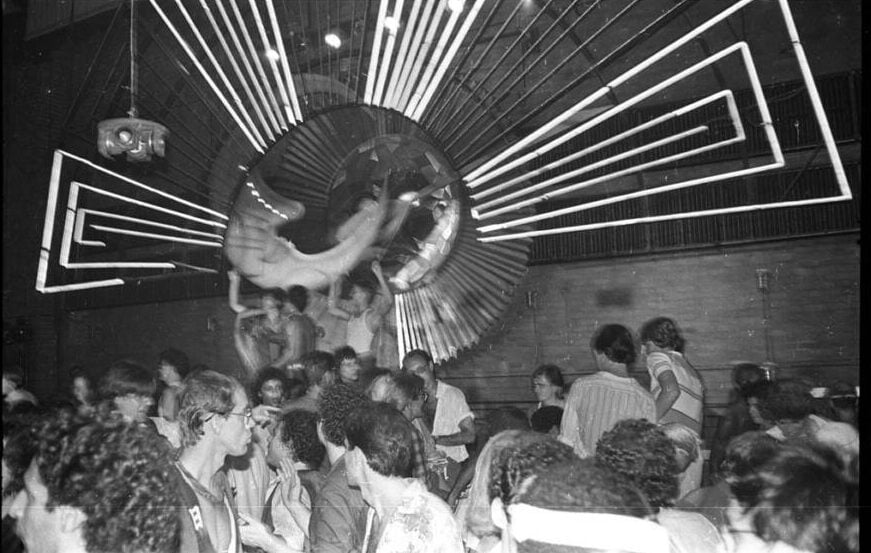
Anton PerichPartygoers enjoy Studio 54, one of the most famous discotheques in the world.
The birth of the disco era reveals a whole roster of social and political issues of the time. Both the women's rights and the civil rights movements were in full swing during the 1960s and 70s. News of the Watergate Scandal broke in 1972. Tensions were brewing between the U.S. and Soviet Union as part of the ongoing Cold War, and in the early 1970s, American troops were still fighting in Vietnam.
Disco emerged in this turbulent time. The movement was about escaping the troubles of the outside world.
"Disco has not gotten true credit," Robert Santelli, author of multiple books on rock and the blues, said in a 2002 New York Times article. "There's a great value in understanding the history of disco because it teaches us what America was about in the 70s."
By the mid-1970s, the music of disco divas like Gloria Gaynor and Donna Summer had made its way from the clubs to the airwaves, spearheading disco's ascent into popular culture.
In 1977, John Travolta's film Saturday Night Fever hit the big screen, complete with a soundtrack from the Bee Gees, signaling that the once-underground disco movement had fully entered the mainstream.
That same year, the most famous disco club in the world opened in Hell's Kitchen, New York: Studio 54. The nightclub was infamous for its focus on sex, drugs, flamboyant fashion, and general debauchery.
But what made discotheques special was that they offered anyone willing to dance the night away a chance to connect with others. Black, white, straight, gay — people left these distinctions at the velvet ropes. Disco was about expressing one's true identity and reclaiming it from the world outside.
Sex, Drugs, And Fashion
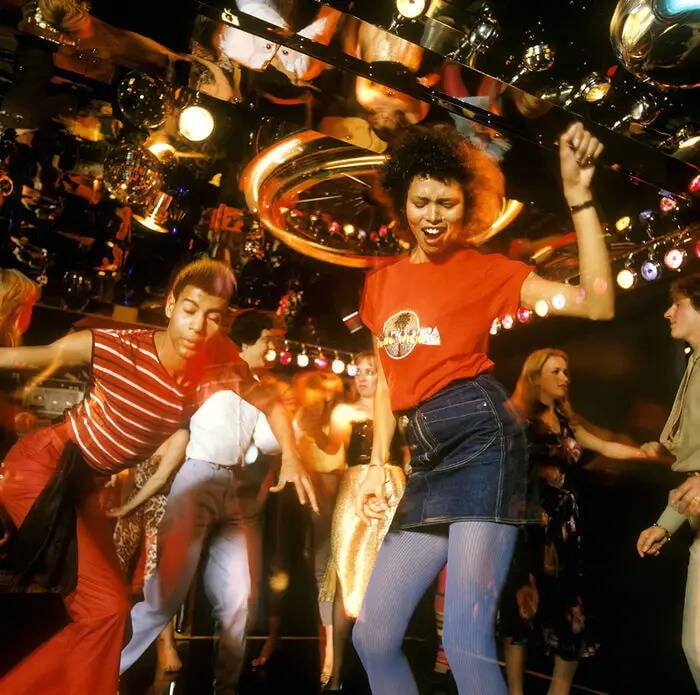
David Redfern/RedfernsPeople dancing at a discotheque in 1978.
Disco shot up in popularity just after mankind made it to the moon and contraceptives became widely available, and part of the music's appeal was its nod to both modernity and futurism — from disco clubs' designs to the music's electric instruments and synthesizers, to the metallic fashion that came with the genre.
In addition to the queer, Black, and Latino clubgoers that pioneered the movement, disco-lovers belonged to one of two groups. The first was young baby boomers who stood on the sidelines of 1960s counter-culture, according to a report by Stanford University dance historian Richard Powers.
As Bruce Pollack, author of The Disco Handbook, explained:
"We had been reminded once too often that we were just not with it. Where they had long hair and Woodstock, we had nothing to clearly call our own. We needed a kind of shared activity, scorned by our elders, which would bring us together as a group. At the disco, we have forged a generational banner."
The other group was made up of working middle class and blue-collar people eager to dress up and have fun in a sophisticated environment.
But regardless of which group you belonged to, everyone shared a common affinity: sex, drugs, and dancing.
"People want to dance because people want to have sex," Fran Lebowitz told Vanity Fair in 2010. "Dancing is sex. That's why when people say, 'I'm a great dancer,' that's not actually what they mean."
The Legacy Of Studio 54, The World's Most Famous Discotheque
Studio 54 was arguably the most exciting discotheque of the disco era. The nightclub welcomed countless celebrities throughout its three-year run, including Andy Warhol, Liza Minnelli, Cher, Dianna Ross, and Mick Jagger — and threw some of the city's most legendary parties.
In a 2013 Vanity Fair article, model and socialite Barbara Allen de Kwiatkowski recalled rubbing shoulders with the rich and famous faces within those walls.
"O.J. Simpson made a pass at me at Studio 54. A really big play. I used to go to dance, but then all these men would chase after you because you were dancing. So I'd go home in Halston's limousine. I'd duck down so they couldn't see me, but they'd run after the car anyway! Oh, God, we had such good times. Remember the fountain that was a block away, in front of one of those big new office buildings on Seventh Avenue? We used to go swimming there after 54 — we'd just flip off our shoes and dive in."
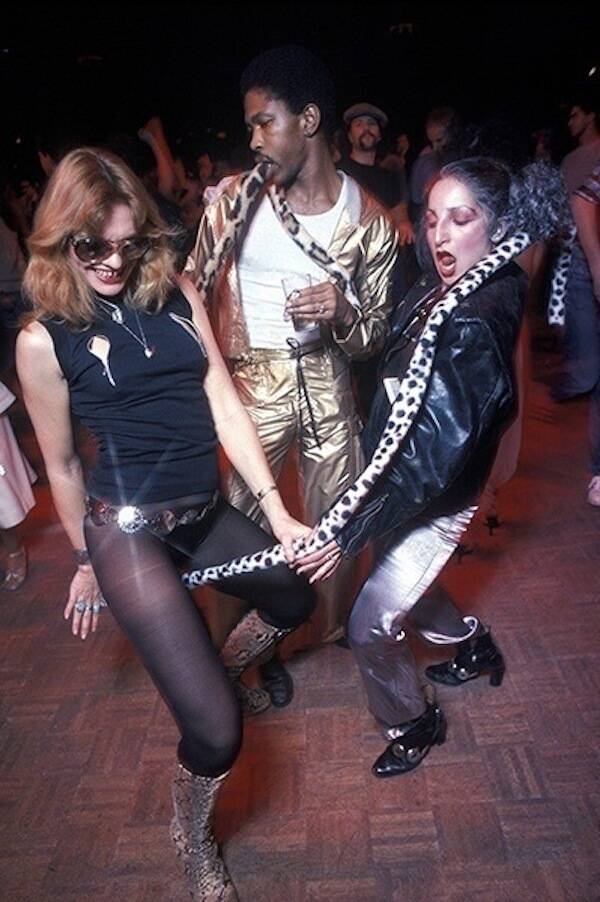
Waring Abbott/Getty ImagesDisco didn't discriminate: If you went to a discotheque to have fun and made a good first impression — through fashion, dance, or personality — you were welcomed with open arms.
Known for its diversity, the club prided itself in being a space for people of all backgrounds, ages, and sexual orientations to party. However, the club was also infamous for its strict and seemingly arbitrary entry requirements. Guests with an eye for fashion who arrived in flamboyant outfits — and varying degrees of nudity — tended to stand a better chance of being let in.
"We called it casting a play, or tossing a salad. We don't want all tomatoes," doorman Marc Benecke recalled, according to Anthony Haden-Guest's 2015 book The Last Party: Studio 54, Disco, and the Culture of the Night. "When you have a lot of lettuce, you have to mix in other ingredients."
He acknowledged that "some big tomatoes get in all the time."
But the club's fun ended with an IRS raid on Dec. 14, 1978. The feds seized bags full of cash and five ounces of cocaine. Owners Steve Rubell and Ian Schrager were arrested for tax evasion, sentenced to three-and-a-half years in prison, and charged $20,000 in fines. The club closed for good in February 1980.
During its prime, however, Studio 54 was an oasis of dance, sexual promiscuity, and liberal drug use. As Grace Jones recalled in her memoir I'll Never Write My Memoirs:
"Up above the balcony, there was the rubber room, with thick rubber walls that could be easily wiped down after all the powdery activity that went on. There was even something above the rubber room, beyond secretive, up where the gods of the club could engage in their chosen vice high up above the relentless dancers. It was a place of secrets and secretions, the in-crowd and inhalations, sucking and snorting."
I Will Survive: Disco In The Modern Era

INTERFOTO/Alamy Stock PhotoDonna Summer, called the "Queen of Disco," in the 1970s.
The most successful disco performers were women, Black artists, and gay men — and their social status lent their music a foundation of resilience and conquering hardship. From Gloria Gaynor and Donna Summer to Village People, crowds gravitated toward the social roots of their art.
"God had to create disco music so I could be born and be successful," Donna Summer has famously said about her work.

Getty Images/Images PressSylvester Stallone and Sheryl Slocum in Studio 54. 1977.
But not everyone embraced disco fever. By the late 1970s, people had begun to push back against the genre and everything it represented, sometimes in aggressive ways.
On July 12, 1979, a group of so-called disco haters flooded the Chicago White Sox stadium and destroyed massive amounts of disco records in what was called Disco Demolition Night.
As part of a promotion to get more sports fans into the ballpark, the team's owner had challenged game attendees to bring disco records with them to be ceremoniously exploded in exchange for a 98-cent ticket. As a result, 50,000 people, mostly disco-haters, attended the game and eventually stormed the field in what can only be referred to as a riot against disco.
This incident, coupled with the AIDS epidemic, spelled the end of the disco era as popular culture's current obsession. Instead, the 1980s brought new music and new trends for the youth to enjoy.
But according to Gloria Gaynor, disco never really went anywhere. It merely infused itself into other genres
"Disco music is alive and well and living in the hearts of music-lovers around the world," she told Vanity Fair. "It simply changed its name to protect the innocent: Dance music. There's no better music for a party — it helps you get rid of the stresses of the day."
From the outdoor dance parties in New York City to music festivals around the world, disco's influence can still be heard in modern house and dance music.
The drugs, fashion, and music might've changed, but the spirit of the 1970s disco era is far from dead. You just have to know where to look.
After learning about the wild days of the disco craze, take a look at 31 eye-opening photos of America's 1970s hippie communes. Then, learn about when crack was king in the 1980s New York in photos.
